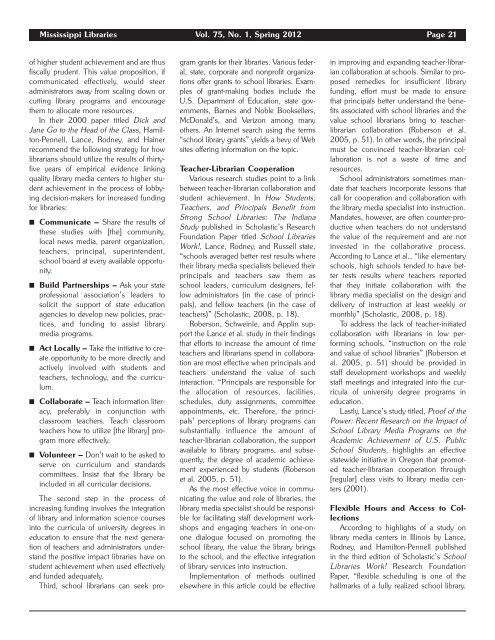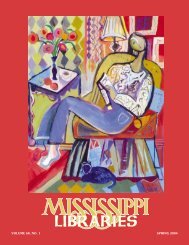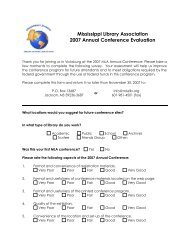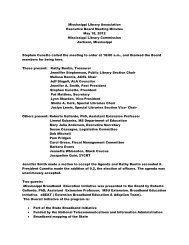Full Text (PDF) - Mississippi Library Association
Full Text (PDF) - Mississippi Library Association
Full Text (PDF) - Mississippi Library Association
Create successful ePaper yourself
Turn your PDF publications into a flip-book with our unique Google optimized e-Paper software.
<strong>Mississippi</strong> Libraries Vol. 75, No. 1, Spring 2012 Page 21<br />
of higher student achievement and are thus<br />
fiscally prudent. This value proposition, if<br />
communicated effectively, would steer<br />
administrators away from scaling down or<br />
cutting library programs and encourage<br />
them to allocate more resources.<br />
In their 2000 paper titled Dick and<br />
Jane Go to the Head of the Class, Hamilton-Pennell,<br />
Lance, Rodney, and Hainer<br />
recommend the following strategy for how<br />
librarians should utilize the results of thirtyfive<br />
years of empirical evidence linking<br />
quality library media centers to higher student<br />
achievement in the process of lobbying<br />
decision-makers for increased funding<br />
for libraries:<br />
Communicate – Share the results of<br />
these studies with [the] community,<br />
local news media, parent organization,<br />
teachers, principal, superintendent,<br />
school board at every available opportunity.<br />
Build Partnerships – Ask your state<br />
professional association’s leaders to<br />
solicit the support of state education<br />
agencies to develop new policies, practices,<br />
and funding to assist library<br />
media programs.<br />
Act Locally – Take the initiative to create<br />
opportunity to be more directly and<br />
actively involved with students and<br />
teachers, technology, and the curriculum.<br />
Collaborate – Teach information literacy,<br />
preferably in conjunction with<br />
classroom teachers. Teach classroom<br />
teachers how to utilize [the library] program<br />
more effectively.<br />
Volunteer – Don’t wait to be asked to<br />
serve on curriculum and standards<br />
committees. Insist that the library be<br />
included in all curricular decisions.<br />
The second step in the process of<br />
increasing funding involves the integration<br />
of library and information science courses<br />
into the curricula of university degrees in<br />
education to ensure that the next generation<br />
of teachers and administrators understand<br />
the positive impact libraries have on<br />
student achievement when used effectively<br />
and funded adequately.<br />
Third, school librarians can seek program<br />
grants for their libraries. Various federal,<br />
state, corporate and nonprofit organizations<br />
offer grants to school libraries. Examples<br />
of grant-making bodies include the<br />
U.S. Department of Education, state governments,<br />
Barnes and Noble Booksellers,<br />
McDonald’s, and Verizon among many<br />
others. An Internet search using the terms<br />
“school library grants” yields a bevy of Web<br />
sites offering information on the topic.<br />
Teacher-Librarian Cooperation<br />
Various research studies point to a link<br />
between teacher-librarian collaboration and<br />
student achievement. In How Students,<br />
Teachers, and Principals Benefit from<br />
Strong School Libraries: The Indiana<br />
Study published in Scholastic’s Research<br />
Foundation Paper titled School Libraries<br />
Work!, Lance, Rodney, and Russell state,<br />
“schools averaged better rest results where<br />
their library media specialists believed their<br />
principals and teachers saw them as<br />
school leaders, curriculum designers, fellow<br />
administrators (in the case of principals),<br />
and fellow teachers (in the case of<br />
teachers)” (Scholastic, 2008, p. 18).<br />
Roberson, Schweinle, and Applin support<br />
the Lance et al. study in their findings<br />
that efforts to increase the amount of time<br />
teachers and librarians spend in collaboration<br />
are most effective when principals and<br />
teachers understand the value of such<br />
interaction. “Principals are responsible for<br />
the allocation of resources, facilities,<br />
schedules, duty assignments, committee<br />
appointments, etc. Therefore, the principals’<br />
perceptions of library programs can<br />
substantially influence the amount of<br />
teacher-librarian collaboration, the support<br />
available to library programs, and subsequently,<br />
the degree of academic achievement<br />
experienced by students (Roberson<br />
et al. 2005, p. 51).<br />
As the most effective voice in communicating<br />
the value and role of libraries, the<br />
library media specialist should be responsible<br />
for facilitating staff development workshops<br />
and engaging teachers in one-onone<br />
dialogue focused on promoting the<br />
school library, the value the library brings<br />
to the school, and the effective integration<br />
of library services into instruction.<br />
Implementation of methods outlined<br />
elsewhere in this article could be effective<br />
in improving and expanding teacher-librarian<br />
collaboration at schools. Similar to proposed<br />
remedies for insufficient library<br />
funding, effort must be made to ensure<br />
that principals better understand the benefits<br />
associated with school libraries and the<br />
value school librarians bring to teacherlibrarian<br />
collaboration (Roberson et al.<br />
2005, p. 51). In other words, the principal<br />
must be convinced teacher-librarian collaboration<br />
is not a waste of time and<br />
resources.<br />
School administrators sometimes mandate<br />
that teachers incorporate lessons that<br />
call for cooperation and collaboration with<br />
the library media specialist into instruction.<br />
Mandates, however, are often counter-productive<br />
when teachers do not understand<br />
the value of the requirement and are not<br />
invested in the collaborative process.<br />
According to Lance et al., “like elementary<br />
schools, high schools tended to have better<br />
tests results where teachers reported<br />
that they initiate collaboration with the<br />
library media specialist on the design and<br />
delivery of instruction at least weekly or<br />
monthly” (Scholastic, 2008, p. 18).<br />
To address the lack of teacher-initiated<br />
collaboration with librarians in low performing<br />
schools, “instruction on the role<br />
and value of school libraries” (Roberson et<br />
al. 2005, p. 51) should be provided in<br />
staff development workshops and weekly<br />
staff meetings and integrated into the curricula<br />
of university degree programs in<br />
education.<br />
Lastly, Lance’s study titled, Proof of the<br />
Power: Recent Research on the Impact of<br />
School <strong>Library</strong> Media Programs on the<br />
Academic Achievement of U.S. Public<br />
School Students, highlights an effective<br />
statewide initiative in Oregon that promoted<br />
teacher-librarian cooperation through<br />
[regular] class visits to library media centers<br />
(2001).<br />
Flexible Hours and Access to Collections<br />
According to highlights of a study on<br />
library media centers in Illinois by Lance,<br />
Rodney, and Hamilton-Pennell published<br />
in the third edition of Scholastic’s School<br />
Libraries Work! Research Foundation<br />
Paper, “flexible scheduling is one of the<br />
hallmarks of a fully realized school library.














